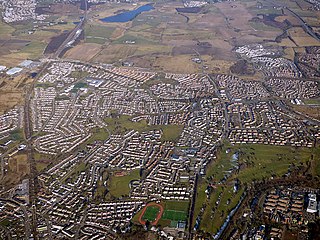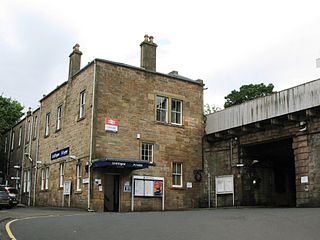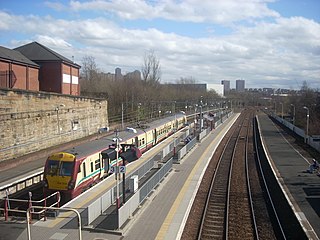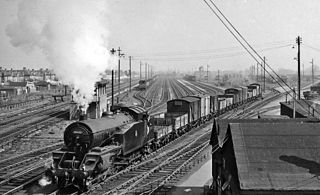
Bishopbriggs ; Scottish Gaelic: Drochaid an Easbaig) is a town in East Dunbartonshire, Scotland. It lies on the northern fringe of Greater Glasgow, approximately 4 miles (6 km) from the city centre. Historically in Lanarkshire, the area was once part of the historic parish of Cadder - originally lands granted by King William the Lion to the Bishop of Glasgow, Jocelin, in 1180. It was later part of the county of Lanarkshire, and then an independent burgh from 1964 to 1975. Today, Bishopbriggs' close geographic proximity to Glasgow now effectively makes it a suburb and commuter town of the city. The town's original Gaelic name Coille Dobhair reflects the name of the old parish of Cadder, but modern Gaelic usage uses Drochaid an Easbaig, a literal translation of Bishopbriggs. It was ranked the 2nd most desirable postcode in Scotland to live in following a study by the Centre for Economic and Business Research in 2015 and 2016.

Glasgow Queen Street is a passenger railway terminus serving the city centre of Glasgow, Scotland. It is the smaller of the city's two mainline railway terminals and is the third busiest station in Scotland behind Central and Edinburgh Waverley.

The North Clyde Line is a suburban railway in West Central Scotland. The route is operated by ScotRail Trains. As a result of the incorporation of the Airdrie–Bathgate rail link and the Edinburgh–Bathgate line, this route has become the fourth rail link between Glasgow and Edinburgh.

The Glasgow–Edinburgh via Falkirk line is a mainline railway line linking Glasgow and Edinburgh via Falkirk in Scotland. It is the principal route out of the five rail links between Scotland's two biggest cities, hosting the flagship "Shuttle" service between Glasgow Queen Street and Edinburgh Waverley. A typical service calls at Glasgow Queen Street, Croy, Falkirk High, Haymarket and Edinburgh or Glasgow Queen Street, Falkirk High, Polmont, Linlithgow, Haymarket and Edinburgh.

Lenzie is an affluent town by the Edinburgh and Glasgow Railway in the East Dunbartonshire council area of Scotland. It is about 6 miles (10 km) north-east of Glasgow city centre and 1 mile (2 km) south of Kirkintilloch. At the 2011 census, it had a population of 8,873. The ancient barony of Lenzie was held by William de Comyn, Baron of Lenzie and Lord of Cumbernauld in the 12th century.
The Edinburgh and Glasgow Railway was authorised by Act of Parliament on 4 July 1838. It was opened to passenger traffic on 21 February 1842, between its Glasgow Queen Street railway station and Haymarket railway station in Edinburgh. Construction cost £1,200,000 for 46 miles (74 km). The intermediate stations were at Corstorphine, Gogar, Ratho, Winchburgh, Linlithgow, Polmont, Falkirk, Castlecary, Croy, Kirkintilloch and Bishopbriggs. There was a ticket platform at Cowlairs. The line was extended eastwards from Haymarket to North Bridge in 1846, and a joint station for connection with the North British Railway was opened on what is now Edinburgh Waverley railway station in 1847.

Drem railway station serves the village of Drem in East Lothian, 5 miles (8 km) from the seaside town of North Berwick in Scotland. It is located on the East Coast Main Line (ECML) 18 miles (29 km) east of Edinburgh Waverley. Passenger services are provided on the ScotRail North Berwick Line, and the junction where the North Berwick branch diverges from the ECML is a short distance to the east of the station.

Croy railway station serves the village of Croy – as well as the nearby town of Kilsyth and parts of Cumbernauld – in North Lanarkshire, Scotland. Located on the Glasgow to Edinburgh via Falkirk Line, 11+1⁄2 miles (18.5 km) northeast of Glasgow Queen Street. It is served by services on the Glasgow–Edinburgh mainline and services between Glasgow Queen Street and Stirling. Train services are provided by ScotRail.

Lenzie railway station is a railway station serving Lenzie and Kirkintilloch in East Dunbartonshire, Scotland. It is located on the Croy Line, 6+1⁄4 miles (10.1 km) northeast of Glasgow Queen Street. Trains on the Glasgow to Edinburgh via Falkirk Line pass Lenzie by. The station is served by ScotRail.

Bishopbriggs railway station is a railway station serving Bishopbriggs in East Dunbartonshire, Scotland. It is located on the Glasgow to Edinburgh via Falkirk Line, 3+1⁄4 miles (5.2 km) north of Glasgow Queen Street, but is currently only served by services on the Croy Line.

Tinsley was a railway marshalling yard near Tinsley in Sheffield, England, used to separate railway wagons from incoming trains and add them to new trains. It was sited immediately west of the M1 motorway, about one mile north of the Catcliffe junction. It was opened in 1965, as a part of a major plan to rationalise all aspects of the rail services in the Sheffield area; it closed in stages from 1985, with the run-down of rail freight in Britain. It was also the site of Tinsley Traction Maintenance Depot (TMD), which was closed in 1998; at its peak, 200 locomotives were allocated to this depot.

Linlithgow railway station is a railway station serving the town of Linlithgow in West Lothian, Scotland. It is located on the Glasgow to Edinburgh via Falkirk Line and is also served by ScotRail services from Edinburgh Waverley to Dunblane, and the daily train between Glasgow Queen Street and the Fife Circle Line.

Rannoch railway station, on the West Highland Line, serves the area of Rannoch in Perth and Kinross, Scotland. Its remote location on Rannoch Moor is picturesque and makes it attractive to walkers. The station has a tea room and visitor centre. In 2017, Simon Jenkins reported it to be one of the best 100 stations in Britain.

Springburn railway station serves the Springburn district of Glasgow, Scotland. The station is 1+1⁄4 miles (2.0 km) north of Glasgow Queen Street station on the Cumbernauld Line and is a terminus of the Springburn branch, a spur from Bellgrove station, on the North Clyde Line.
The Monkland and Kirkintilloch Railway was an early mineral railway running from a colliery at Monklands to the Forth and Clyde Canal at Kirkintilloch, Scotland. It was the first railway to use a rail ferry, the first public railway in Scotland, and the first in Scotland to use locomotive power successfully, and it was a major influence in the successful development of the Lanarkshire iron industry. It opened in 1826.
The Edinburgh Glasgow Improvement Programme or EGIP was an initiative funded by Transport Scotland on behalf of the Scottish Government to increase capacity on the main railway line between Edinburgh and Glasgow, with new, longer electric trains running by 2017 and scheduled for full completion in 2019. It was expected to cost £742 million and delivered by Network Rail.
Manuel Junction is a railway junction near the village of Whitecross, Falkirk, Scotland. It is the terminus of the Bo'ness and Kinneil Railway and forms a connection between it and the Glasgow–Edinburgh via Falkirk line.

Feltham marshalling yard, also known as Feltham hump yard, was a large railway marshalling yard designed for the concentration of freight traffic to and from South West London, and for transfer to other marshalling yards in London. It was built on the Waterloo to Reading Line. It opened in 1918 and was closed by British Railways on 6 January 1969.
Events from the year 1841 in Scotland.
Railway electrification in Scotland has proceeded in a different fashion than the rest of the UK especially in the 21st Century. There is political commitment to a substantial rolling programme of railway electrification from the Scottish government where transport is devolved. Transport Scotland and others have said "In Scotland, decarbonisation is spelt E-L-E-C-T-R-I-F-Y". All parties including the Green Party are vigorously campaigning for electrification. As of January 2022, there is 2776 kilometres of track in Scotland, and 711 kilometres are electrified representing 25.3%. To meet these needs, the plan is to electrify on average 130 single track kilometres (STK) per year until 2035.















